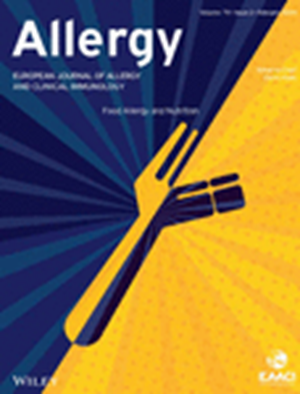体外免疫法定量佐剂类过敏原
IF 12.6
1区 医学
Q1 ALLERGY
引用次数: 0
摘要
许多IgE介导的过敏性疾病可以用过敏原免疫疗法(AIT)治疗。为了提高安全性和有效性,一些AIT产品含有过敏原提取物,这些过敏原提取物通过化学交联产生类过敏原,并吸附在氢氧化铝佐剂上。这种修饰和吸附损害了蛋白质的可及性和类过敏原含量的定量。方法采用ELISA - like法定量测定加佐剂草花粉类过敏原AIT产品(从此称为:AIT药物产品;AIT - DPs)采用荧光检测系统制备。氢氧化铝颗粒的高密度使抗原复合体能够通过离心成球。采用兔抗草花粉样过敏原血清或小鼠抗php5单克隆抗体(mAb)作为一抗。用氮分析法测定样品的蛋白质含量。结果经等电聚焦、凝胶电泳和免疫印迹检测,一抗具有较高的特异性。草花粉AIT - DPs具有高特异性,与树花粉或螨AIT - DPs具有低或无交叉反应性。它被用来确认不同草花粉AIT - DPs的批间一致性和类过敏原含量。总的来说,相对于它们的总蛋白质含量,相对于内部参考,所有草花粉AIT - DPs的类过敏原含量在0.8到2.1之间,而使用mAb则显示了php5含量的产品特异性差异。此外,该分析检测热应力引起的产品变化。结论本方法可用于定量氢氧化铝配合物中类过敏原的含量和质量。它适用于体外无动物最终产品测试,例如,用于批放行,以确保AIT - DPs的质量。本文章由计算机程序翻译,如有差异,请以英文原文为准。
Immunological In Vitro Assay for Quantification of Adjuvanted Allergoids
BackgroundMany IgE‐mediated allergic disorders can be treated with allergen immunotherapy (AIT). In order to improve safety and efficacy, some AIT products contain allergen extracts which are chemically cross‐linked to generate allergoids and are adsorbed to aluminum hydroxide adjuvant. The modification and adsorption impair accessibility of the protein and quantification of the allergoid content.MethodsAn ELISA‐like assay to quantify the allergoid content in adjuvanted grass pollen allergoid AIT products (from here on called: AIT drug products; AIT‐DPs) was developed using a fluorescence detection system. The high density of the aluminum hydroxide particles enabled pelleting the antigen complexes by centrifugation. Rabbit anti‐grass pollen allergoid sera or a mouse anti‐Phl p 5 monoclonal antibody (mAb) was used as the primary antibody. Protein content of the samples was quantified by nitrogen analysis.ResultsHigh specificity of the primary antibodies was confirmed by isoelectric focusing, gel‐electrophoresis, and immunoblotting. Performance of the allergoid content assay was demonstrated in grass pollen AIT‐DPs with high specificity and low/absent cross‐reactivity with tree pollen or mite AIT‐DPs. It was used to confirm batch‐to‐batch consistency and allergoid content of distinct grass pollen AIT‐DPs. Overall, in relation to their total protein content, the allergoid content ranged between 0.8 and 2.1 relative to an in‐house reference for all grass pollen AIT‐DPs, whereas use of mAb revealed product‐specific differences in the Phl p 5 amount. Additionally, the assay detects product alteration by heat stress.ConclusionThe described assay is suitable to quantify the allergoid content and quality of allergoids in complex with aluminum hydroxide. It is suitable for animal‐free final product testing in vitro, for example, for batch release to ensure the quality of AIT‐DPs.
求助全文
通过发布文献求助,成功后即可免费获取论文全文。
去求助
来源期刊

Allergy
医学-过敏
CiteScore
26.10
自引率
9.70%
发文量
393
审稿时长
2 months
期刊介绍:
Allergy is an international and multidisciplinary journal that aims to advance, impact, and communicate all aspects of the discipline of Allergy/Immunology. It publishes original articles, reviews, position papers, guidelines, editorials, news and commentaries, letters to the editors, and correspondences. The journal accepts articles based on their scientific merit and quality.
Allergy seeks to maintain contact between basic and clinical Allergy/Immunology and encourages contributions from contributors and readers from all countries. In addition to its publication, Allergy also provides abstracting and indexing information. Some of the databases that include Allergy abstracts are Abstracts on Hygiene & Communicable Disease, Academic Search Alumni Edition, AgBiotech News & Information, AGRICOLA Database, Biological Abstracts, PubMed Dietary Supplement Subset, and Global Health, among others.
 求助内容:
求助内容: 应助结果提醒方式:
应助结果提醒方式:


